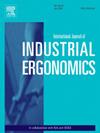Effects of passive shoulder-support exoskeleton entity and support force on user range of motion under external loads
IF 2.5
2区 工程技术
Q2 ENGINEERING, INDUSTRIAL
International Journal of Industrial Ergonomics
Pub Date : 2024-10-13
DOI:10.1016/j.ergon.2024.103655
引用次数: 0
Abstract
This study investigates the effects of a passive shoulder-support exoskeleton entity and support force on the range of motion (ROM) of the shoulder and trunk. Twenty-six healthy participants underwent ROM assessments across three exoskeleton setting conditions (without the exoskeleton; wearing the exoskeleton but the support force deactivated; wearing the exoskeleton with the support force activated) and three external load conditions (0 kg, 3 kg, and 6 kg). Results show that while the exoskeleton entity constrained the shoulder ROM (vertical abduction/adduction, flexion/extension, and horizontal abduction/adduction) and trunk ROM (lateral flexion and rotation), the support force partially alleviated this constraint. External loads primarily restricted the mobility of the shoulder but not the trunk. Interaction effects revealed the complex interplay between external loads and exoskeleton settings on ROM and perceived difficulty, particularly in shoulder vertical abduction/adduction. This study underscores the necessity of considering exoskeleton entity, support force, and external loads in optimizing user joint mobility.
The industrial exoskeleton represents a promising solution for enhancing workplace safety and productivity by mitigating work-related musculoskeletal disorders. This study assessed the impact of the exoskeleton's entity and support force on joint mobility across different load scenarios. Joint mobility is critical to perform industrial tasks that require high flexibility and agility.
被动肩部支撑外骨骼实体和支撑力对使用者在外部负荷下活动范围的影响
本研究调查了被动肩部支撑外骨骼实体和支撑力对肩部和躯干运动范围(ROM)的影响。26 名健康参与者在三种外骨骼设置条件(不穿外骨骼;穿外骨骼但支撑力失效;穿外骨骼但支撑力激活)和三种外部负载条件(0 千克、3 千克和 6 千克)下接受了运动范围评估。结果表明,虽然外骨骼实体限制了肩关节活动度(垂直外展/内收、屈伸和水平外展/内收)和躯干活动度(侧向屈伸和旋转),但支撑力部分缓解了这种限制。外部负荷主要限制了肩部的活动度,但没有限制躯干的活动度。交互效应揭示了外部负荷和外骨骼设置对ROM和感知难度的复杂相互作用,尤其是在肩部垂直外展/内收方面。这项研究强调了在优化用户关节活动度时考虑外骨骼实体、支撑力和外部负载的必要性。工业外骨骼是一种很有前景的解决方案,它可以通过减轻与工作相关的肌肉骨骼疾病来提高工作场所的安全性和生产率。本研究评估了外骨骼的实体和支撑力在不同负载情况下对关节活动度的影响。关节活动度对于执行需要高度灵活性和敏捷性的工业任务至关重要。
本文章由计算机程序翻译,如有差异,请以英文原文为准。
求助全文
约1分钟内获得全文
求助全文
来源期刊
CiteScore
6.40
自引率
12.90%
发文量
110
审稿时长
56 days
期刊介绍:
The journal publishes original contributions that add to our understanding of the role of humans in today systems and the interactions thereof with various system components. The journal typically covers the following areas: industrial and occupational ergonomics, design of systems, tools and equipment, human performance measurement and modeling, human productivity, humans in technologically complex systems, and safety. The focus of the articles includes basic theoretical advances, applications, case studies, new methodologies and procedures; and empirical studies.

 求助内容:
求助内容: 应助结果提醒方式:
应助结果提醒方式:


